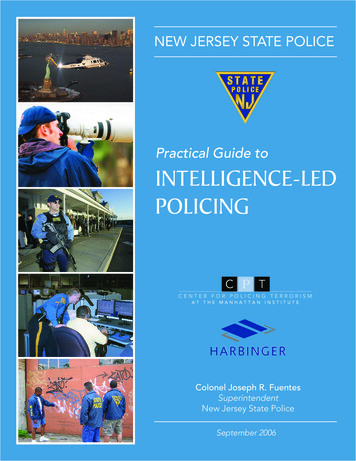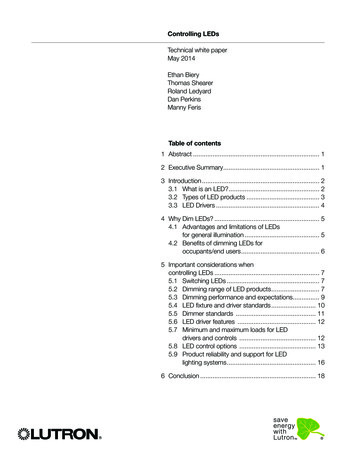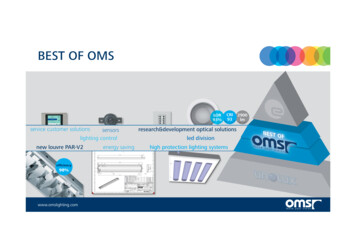
Transcription
NEW JERSEY STATE POLICEPractical Guide toIntelligence-LedPolicingC P TC e n t e r f o r P o l i c i n g T e rr o r i s mATTHEMANHATTANINSTITUTEColonel Joseph R. FuentesSuperintendentNew Jersey State PoliceSeptember 2006
New Jersey State Police Practical Guide to Intelligence-led Policing
The Project Committee to Integrate Intelligence-led PolicingWithin the New Jersey State PoliceSeptember 26, 2006Ray GuidettiDetective Sergeant First ClassTo our Readers:Greg DemeterDetective IFive years ago, our nation was violently attacked and thousands of innocentAmericans died at the hands of international terrorists. A third of those victimsresided in New Jersey, reminding us that terrorism is truly a local issue. Moreover,eleven of the nineteen hijackers spent time in New Jersey planning and executingthe dreadful assault on America. Their presence here illuminates an existing vulnerability in our free society - terrorists are capable of carrying out attacks fromour backyards. This alarming discovery has thrust policing into a new era, an erathat requires police organizations to manage risk more effectively and efficiently.For the State Police, policing in the Homeland Security Era has involved significant architectural and process changes.Dean BarattaAnalystJustin WagnerAnalystFrank E. RodgersLieutenant ColonelDeputy Superintendent of InvestigationsNew Jersey State PoliceJ. Michael BarrettResearch FellowHarbinger/ICx TechnologiesManhattan InstituteGerard LaSalle, Ph.D.ProfessorEast Stroudsburg UniversityJohn Rollins, J.D.ResearcherCenter for Homeland Defense andSecurity Naval Postgraduate SchoolA year ago, the Deputy Superintendent of Investigations commissioned a project to design and produce a manual to guide intelligence operations within theState Police. At the time, the Investigations Branch was undergoing a wholesaletransformation to increase its efficiency and effectiveness of operations. Centralto the Branch’s reorganization was elevating the stature of the intelligence function. Prior to the reorganization only select members of the Branch were responsible for collecting and sharing intelligence. After the reorganization, all Branchmembers would bear this vital and essential duty. As the reorganization projectevolved, so did the intelligence manual project. The final report before you is theculmination of a year’s work and a great deal of collaboration among a team ofdedicated professionals. It reveals a document that has expanded from its originaldesign and now focuses on the intelligence-led policing construct currently being integrated within the State Police to create a mission capable force in an “allcrimes, all hazards, and all threat” environment.The NJSP Practical Guide to Intelligence-led Policing was born from the Superintendent’s mandate that in order to secure our homeland and sustain our hometown way of life we must revolutionize the manner in which we police. We deliverthis report in response to this mandate. We certainly expect it will challenge thestatus quo of how policing is performed within the State Police.Following this roadmap to change, impelled by a sense of urgency to prevent thenext terrorist attack or respond to the next man-made or natural disaster, the StatePolice has adopted a paradigm of policing aimed at interpreting the environmentwe police. The 3i Model of intelligence-led policing, crafted by the renownedDr. Jerry Ratcliffe of Temple University, has provided us with the philosophicalfoundation needed to anchor policy and strategy. Over the past year, Dr. Ratcliffehas repeatedly provided his expertise in order to assist us in preparing this reference guide. We are grateful for his interest and enthusiasm in this revolutionaryState Police project.
New Jersey State Police Practical Guide to Intelligence-led PolicingApplying the precepts of intelligence-led policing within ourlong established legal framework designed to guarantee ourcivil liberties requires a delicate balance between security andliberty. We are especially thankful to Deputy Attorney General Dave Rebuck of the New Jersey Attorney General’s Office for his attention to detail needed to ensure we did not“push the envelope” with our application of the intelligencereport. His guidance was reverberated in the advice of JimWilson and the team at the Institute for Intergovernmental Research (IIR). Having the endorsement from this truegroup of professionals on the intelligence report chapter willassist us in maintaining the true value of intelligence collection without corroding the same liberties we are empoweredto defend.Achieving proficiency in intelligence-led policing requiresspecific process changes to “operationalize” philosophy. Weare indebted to the Manhattan Institute Center for PolicingTerrorism for helping us work toward and realize this overarching goal. Director Tim Connors has been instrumentalin providing subject matter experts that our team could consult concerning policy, strategy, and the operations of intelligence. The wisdom of Harbinger/ICx Technologies ResearchFellow J. Michael Barrett is woven through the pages of thisguide. His professionalism, wit, and overall dedication to theproject – underscored by his notion that securing Americarequires distinct process changes – have served to reorientour bearing on many instances. We will always consider himpart of our team.It is true that the State Police cannot achieve the paradigmof intelligence-led policing without a robust analytical workforce. Today we continue to work toward this end and are forever grateful for the insights and acumen of Marilyn Peterson.Working in cooperation with our team she has supplied ouranalysts with the training requisite of a professional analytical apparatus. Her curricula will perpetually counsel our nextgeneration of analysts in the skill sets needed to achieve successin this domain. As one of the nation’s leading voices on intelligence analysis, we are indebted to her counsel.This monograph is a practical guide primarily concerned withthe principles that generate policy, both current and future,regarding the way the State Police interprets intelligence-ledpolicing. It is intended to challenge its readers to come toterms with intelligence-led policing. Contained throughoutthis guide is a host of references deliberately placed to supplythe basic vocabulary of intelligence-led policing. Once a language is standardized and a baseline familiarity is attained,our efforts to achieve strategy will be maximized. It is thenthat our leadership can focus their attention on the forcesthat help and hinder efforts to achieve the State Police’s overall intelligence-led policing strategy.Practical guides come in two types. Some are a presentationof rules; others deal largely with the principles that underliesuch rules. This guide follows the latter. As such, it requiresaction by the reader to be effective. In other words, thisguide addresses the many problems inherent to policing inthe Homeland Security Era and provides the reader with theprinciples for solving such problems. However, the problemsto be solved are practical and require action at the level ofthe individual. It is our hope that the knowledge conveyed inthis guide will engender action in the form of creating policy,strategy, training, and operations needed to solve the practical problems of policing in the new era.We complete our project with a great sense of accomplishment. We thank those who have contributed to it over thelast year and provided the crucial insight necessary for sucha mass undertaking. We are certain that we will be a betterpolicing organization for it. Most importantly, this month isthe anniversary of the September 11, 2001 terrorist attacks.It serves as a reminder of why we cannot ever waver in ourresolve to defend America through effective policing.Ray GuidettiDetective Sergeant First ClassNew Jersey State Police
Table of ContentsForeword.1Executive Summary.2Section One: The NJSP Approach to Intelligence-led Policing.3Section Two: The Intelligence Cycle and the NJSP.6Section Three: The New Jersey Regional Operations and Intelligence Center (ROIC) Task Force.10Section Four: Roles and Functions of Key Players in Intelligence-led Policing.13Section Five: The Intelligence Report.14Section Six: Analytical Intelligence Products.26Section Seven: Key NJSP Intelligence Resources.33Section Eight: Conclusion.35Bibliography.37
New Jersey State Police Practical Guide to Intelligence-led Policing
ForewordThis New Jersey State Police (NJSP) Practical Guide to Intelligence-led Policing details the processes that the NJSP hasadopted in order to operationalize the principles of Intelligence-led Policing (ILP). It was written to ensure that all membersof the NJSP share the same understanding of the concepts and vernacular that we have embraced to institutionalizeintelligence as the foundation of all operations. The need for this guide was born from the understanding that before anylaw enforcement organization can benefit from the use of intelligence its members must truly understand the fundamentalconcepts linked to the application of intelligence and ILP. In essence, this guide is a reference for the trooper on patrol,our analysts, detectives in the field, and the NJSP’s senior leadership. It acknowledges that we recognize that our primaryresponsibility as a state policing organization is to prevent and disrupt crime and terrorism and that we will do so byleveraging an intelligence apparatus that communicates clearly, shares information, and focuses resources.A Word about Law Enforcement & IntelligenceIntelligence is often referred to as a powerful tool in a law enforcement organization’s arsenal. It has the capacity to provideleaders with an operational picture of the environment that requires focused resources. It can aid analysts in determininghow an organization should tackle problems. Moreover, it can provide operators with the requisite knowledge for centeringinvestigations on specific targets. In sum, intelligence, as a structure, a process, and a product, is capable of strengtheninga law enforcement organization’s approach to better understanding the environment in which they police.Just as intelligence is a powerful tool, it can be a potent enemy to a free society when practiced outside its legal boundaries.As a western democracy, the United States offers its citizens a considerable amount of liberty. The freedom to exercisethis right is, in turn, contingent upon the law enforcement community exercising prudent restraint when striking a balancebetween protecting freedoms and ensuring security. The Tenth Amendment of the U.S. Constitution, also known as the“Police Powers Amendment,” affords the States the authority to exercise sovereignty from the federal government inproducing state initiatives. It endows the States with the authority to provide for their independent security – securityfrom crime and terrorism. Although collecting intelligence on our citizens is a powerful tool for preventing crime andstopping terrorism, the police may do so only in a manner consistent with the Constitution. As a professional and ethicalpolicing organization, it is our duty to ensure that when collecting and reporting information that is sensitive in nature,we do so with the highest degree of prudence toward protecting the rights of our citizens.To safeguard the citizens of New Jersey from overzealous intelligence practices that may threaten the freedoms of ourcitizens, the NJSP will always exercise the highest degree of caution and professionalism when employing intelligenceoperations. In designing this guide, the NJSP was sensitive to the tenets outlined in Title 28 Code of Federal Regulation,Part 23, and the Attorney General Guidelines on the Collection, Handling, Storage and Dissemination of Intelligence inNew Jersey. However, since it is outside the scope of this document to address all of the legal considerations involving theapplication of intelligence, readers are reminded to continually refer to the above-mentioned documents for direction.Frank E. RodgersLieutenant ColonelDeputy Superintendent of InvestigationsNew Jersey State Police1
New Jersey State Police Practical Guide to Intelligence-led PolicingExecutive Summarycan impact their environment through strategic, operational,or tactical initiatives.Recent decades have witnessed a rapid spread of communicationsand other technologies across all facets of society, enablingsmall and previously disassociated groups to better coordinatetheir activities and learn from each other in furtherance oftheir objectives. While such advancements have increasedproductivity and cooperation for the population overall, theyhave also created new opportunities for those outside the law,including organized criminal elements and terrorists. As aresult, today’s criminals are displaying increased sophisticationand operational agility in their efforts to subvert law and order.These changes in the individuals and organizations carryingout criminal and other activities have culminated in the needto modernize the NJSP’s business processes to optimize theallocation of resources and concentrate efforts in a morestructured manner.Implementation of ILP at the NJSP is comprised of fourmain components: the reorganization of the InvestigationsBranch to better facilitate rapid deployment of intelligence andinvestigative assets as needed; the adoption of the IntelligenceCycle to support better situational awareness; the creation of aRegional Operations and Intelligence Center (ROIC), whichis designed to provide tactical situational awareness; and useof strategic planning and intelligence-driven analyses to setpriorities and allocate resources (see Figure 2 Decision-makerFigure 1. 3i Model of Intelligence-led Policingadapted from RatcliffeStrategic Planning& IntelligenceDriven AnalysisFigure 2. Four components of ILP implementationThis New Jersey State Police Practical Guide to Intelligence-ledPolicing is a comprehensive resource outlining the NJSP’sphilosophy of ILP to achieve better situational awarenessthrough the collection of data and the creation, dissemination,and cataloguing of intelligence products. These productswill drive strategic decision-making and structured resourceallocation to enable the NJSP to appropriately meet currentand future challenges. This guide also defines the processesassociated with intelligence that will be incorporated intoNJSP-wide crime prevention and emergency managementstrategies. The primary aspect of this process is grounded bythe need to establish a common understanding of the operatingenvironment, a task that is achieved through the combinedefforts of the Investigations Branch’s formal Intelligence Cycleand the Regional Operations and Intelligence Center (ROIC)’sreal-time situational awareness efforts.As New Jersey navigates toward a new normalcy focusedon homeland and hometown security, it must improveits information and intelligence sharing capabilities. Theseries of processes and procedures the NJSP has adopted tomeet these challenges is an adaptation of the 3i Model ofIntelligence-Led Policing (ILP). The 3i Model (see Figure1) introduced by Dr. Jerry Ratcliffe of Temple Universityis an approach to policing and resource allocation thatplaces a great deal of emphasis on interpreting the criminalenvironment in order to influence decision-makers andcreate desired impacts upon the criminal environment.Collecting and analyzing information to produce finishedintelligence products will provide decision-makers withsituational awareness and a common understanding of theoperating environment. Once informed, decision-makers2
Intelligence-led Policing (ILP)often incorrectly used interchangeably with the terms dataor information. In the past problems have arisen when lawenforcement agents have misused official intelligence orwhen the general public has misunderstood the nature ofthe data being collected. For these reasons, it is importantthat particular care is taken when describing the nature ofthe information in question. Data/information refers simplyto the raw information thatis collected but has notInformation isbeen analyzed. It is criticalthe principlethat wide varieties of data/information be collectedelement offor two reasons: First,knowledgedata is often perishablethat enablesin nature and will be lostrationalforever if it is not collectedand catalogued at the timedecision-makingit is first encountered;and second, seeminglyinnocuous data might become critical in light of furtheranalysis, which is akin to how all evidence at a crime sceneis carefully catalogued in case it later becomes relevant tothe case. Intelligence is the product of careful evaluationand analysis of all the collected data. Intelligence isthen disseminated in reports and other products thatenable operators, analysts, and senior leadership to betterunderstand our collective operating environment and todrive appropriate resource allocation.Intelligence-led policing is a collaborative philosophythat starts with information, gathered at all levels of theorganization that is analyzed to create useful intelligence andan improved understanding of the operational environment.This will assist leadership in making the best possible decisionswith respect to crime control strategies, allocation of resources,and tactical operations. The adoption of ILP processes requiresa concerted effort by all parties, including analysts, operators,and senior leaders. For analysts the key components of thisprocess include the creation of tactical, operational andstrategic intelligence products that support immediate needs,promote situational awareness, and provide the foundationfor longer-term planning. For operators it requires becomingboth better data collectors and better consumers of intelligencerelated products. This means shifting from emphasizing postevent evidence collection to constantly gathering all relevantdata and ensuring it is provided for entry into appropriatedatabases, as well as drawing from the intelligence analystsand relevant databases all the information that is needed tosupport ongoing operations. Finally, adopting the ILP processrequires senior leadership to actively engage the analysts andthe operators to ensure the leadership has a sufficient pictureof the operating environment and that it can act to distributeresources according to conclusions and priorities drawn fromthis understanding.Information/Data Analysis IntelligenceSection One: The NJSP Approachto Intelligence-led PolicingInformation, Data and IntelligenceThe Tradition of Intelligence in the NJSPUnprocessed information, or raw data, represents theprinciple element of knowledge and as such is a critical inputfor rational decision-making. It can be used to create awarenessand provide direction for ongoing and future activities.When properly analyzed and evaluated it can then be turnedinto a derivative known as “intelligence.” In other words,information that has been transformed through evaluation andanalysis into intelligence can be used to create a value-addedproduct tailored to fulfill the requirements of its consumers.The New Jersey State Police has maintained an activeintelligence component for several decades, and has a historyof anticipating changes to the criminal environment. In April1967, then-Superintendent Colonel David B. Kelly dedicateda group of detectives to investigate organized crime by creatingan Intelligence Bureau. Through the continued efforts ofColonel Kelly and other members of the State Police, thelegislature enacted new laws governing electronic surveillance,witness immunity, and a creation of a statewide grand jury tofocus on organized crime.Intelligence is the synthesis of known data/informationand analytical reasoning to create a determination about theoverall operating environment. Unfortunately, intelligence isIn the decades that followed, the focus of organizedcrime investigations changed, and the Intelligence Bureau3
New Jersey State Police Practical Guide to Intelligence-led PolicingE E F FECCOORDINATIONOF EFFORTE As depicted in Figure 3, the keys to more effectivepolicing include greater information sharing, improvedcommunication, and enhanced coordination of effort andresource allocation.GINaddressed these challenges with the addition of three regionalintelligence units. When the first casino opened in AtlanticCity in 1976, NJSP commanders recognized the need toalso develop intelligence on organized crime in the casinoFigure 3. Keys to More Effective PolicingIntelligence-Led Policing (ILP)industry, and the Intelligence Bureau expanded to include aCasino Intelligence Unit. Throughout the 1980s, detectivesassigned to the Intelligence Bureau both spearheaded andassisted the NJSP’s Organized Crime Bureau to investigate andprosecute numerous high profile organized crime cases. In the1990’s, the intelligence initiatives expanded to include drugtrafficking and street gang activities. For nearly 40 years, theNJSP has deeply valued the concepts of intelligence, devotingconsiderable resources to the cause.Intelligence-led policing is a management philosophysupporting optimal resource allocation based on fullyunderstanding the operating environment. It is adapted fromthe United Kingdom’s law enforcement community and hasrecently gained traction in the United States, particularlyfollowing the release of the National Criminal IntelligenceSharing Plan. ILP is a collaborative philosophy based onimproved intelligence operations to aid in understandingchanges in the operating environment to enable lawenforcement to rapidly adjust to new circumstances. Thisphilosophy supports decision makers who seek intelligenceto improve their judgment and enable them to make the bestpossible decisions with respect to crime control strategies,allocation of resources, and tactical operations.Yet today, as the State Police enters the new era of HomelandSecurity, its long-established intelligence construct cannotsustain the demands intrinsic to this new age. The intelligenceprocesses of the past were aimed largely at organized criminalactivities, creating a honed approach toward this end.Conversely, this focus also indirectly spawned information andoperational silos that restricted the application of intelligenceamong select groups within the NJSP’s former IntelligenceServices Section. The threats the NJSP faces today haveexpanded beyond the criminal realm into terrorism and manmade and natural disasters. The hazards abound require theSuperintendent to broaden the NJSP’s scope and applicationof intelligence outside its traditional pathways and set anew direction to follow. Intelligence-led policing is the newintelligence course toward which the NJSP will set its sails.The key to ILP is to answer the need for targetedresource allocation to combat crime, terrorism and otherlaw enforcement issues through improved situationalawareness. For the trooper on the road, this requires feedinginformation into intelligence databases and receivingintelligence to assist patrol operations. At the detectiveand analysts’ level, it refers to the broader understandingof issues that affect the NJSP throughout the state, as well4
as in neighboring states. Finally, for the senior leadershipit requires an awareness of events that affect the broaderscope of all NJSP and partner activities.4. The creation of a “fusion center,” known as the RegionalOperations and Intelligence Center.5. The implementation of regional accountability plans formanaging intelligence and enforcement operations relatedto organized criminal activities1.Implementing ILPIn support of the structural changes outlined above, the decisionwas made to adapt intelligence-related NJSP policies andprocedures to the contours of the intelligence cycle, which is atried and true method of managing and promoting a constructiveand orderly interface among data collectors, intelligence analysts,field operators, and intelligence product consumers.The NJSP is aggressively changing its operational processesto bring improved structure to its near, mid and long-termplanning and to optimize resource allocation decisions. Thischange requires a concerted effort by all parties – senior leaders,emergency management personnel, operators and analysts– in adopting an appropriate variant of the Intelligence-LedPolicing model that is consistent with the mission, strategy,and core values of the NJSP. The tenets of the ILP process aredefined by the simultaneous and ongoing implementation offour primary facets (see Figure 2 above): the reorganization ofthe NJSP to ensure an adaptable force construct for flexibledeployment; adoption of the Intelligence Cycle for processingand analyzing data; development and integration of ROICfunctions; and use of strategic planning and intelligence-drivenanalyses to set priorities and allocate resources.ILP Role of Strategic LeadershipAdopting the ILP process requires senior leadership to activelyengage the analysts and the operators to ensure the leadershiphas a sufficient picture of the operating environment and thatit can act to distribute resources according to conclusions andpriorities drawn from this understanding.ILP Role of Operators (Troopersand Detectives)NJSP Reorganization: an ILP InitiativeIn 2005 the New Jersey State Police Investigations BranchCommand began a careful review of its existing intelligenceinfrastructure to determine whether the organization hadadapted to the challenges of policing in an era when bothhomeland security and traditional crime control placeconsiderable demands on finite resources. After carefulstudy, several barriers were identified and a strategic plan wascrafted to transform the Investigations Branch into an agileinvestigative entity capable of tackling “all crimes, all hazards,all threats.” The NJSP developed five strategies to ensure thesuccess of this endeavor:For operators ILP requires becoming both better datacollectors and better consumers of intelligence relatedproducts. This means shifting from emphasizing post-eventevidence collection to constantly gathering all relevantdata and ensuring it is provided for entry into appropriatedatabases, as well as drawing from the intelligence analystsand relevant databases all the information that is needed tosupport ongoing operations.1. An architectural realignment of the organizationto remove barriers and promote intelligence andinformation exchange.2. A cultural shift to embrace intelligence-led policingphilosophies and practices.3. The re-tooling of the distribution and management of theStatewide Intelligence Management System (SIMS).For analysts the key components of the ILP process includethe creation of tactical, operational and strategic intelligenceproducts that support immediate needs, promote situationalawareness, and provide the foundation for longer-termplanning. The Intelligence Analyst also plays a vital rolein the Intelligence Cycle. In addition to assisting in thecreation of the Collection Intent, the Intelligence Officer isILP Role of Analysts1NJSP Investigations Branch. 2005. “Confronting the Investigative Challenges of the Homeland Security Era: Reorganizing theNJSP Investigations Branch.”5
New Jersey State Police Practical Guide to Intelligence-led Policingresponsible for making sure the Collection Plan remains adynamic, living product.intelligence requirements remain. The cycle begins anewas new requirements are again balanced against commandguidance, operational needs, and resource constraints.ILP Role of the ROICThe NJSP intelligence cycle generally consists of fivecontinuing phases: Planning and Direction, Collection,Analysis and Production, Dissemination, and Evaluation(see Figure 4).The functions of the ROIC are three-fold: conducting watchfloor operations (Watch Ops), real-time tactical intelligenceanalysis (Analysis), and tracking assets (Asset Management andCoordination). During daily operations, these functions areperformed to create a complete picture of the current operatingenvironment throughout the state of New Jersey, includingexternal factors that may also present immediate concerns(terrorism, severe weather events, gang or drug problems inneighboring states, etc.) as well as the resources available toaddress them. During crisis operations these same functionsremain paramount, albeit with much greater immediacy ofinformation flow and expanded outreach to and integrationwith external agencies and federal partners. Drawing upon itsresources and partners, the ROIC remains the center of gravityfor the creation of a comprehensive common operating pictureof relevant events and happenings within the state.Section Two: The Intelli
The need for this guide was born from the understanding that before any law enforcement organization can benefit from the use of intelligence its members must truly understand the fundamental concepts linked to the application of intelligence and ILP. In essence, this guide is a reference for the trooper on patrol,




![Amalfi 180 Led Otto [28.01.22]](/img/23/022e99f7-d57e-51b4-8c41-152437a0d633.jpg)






